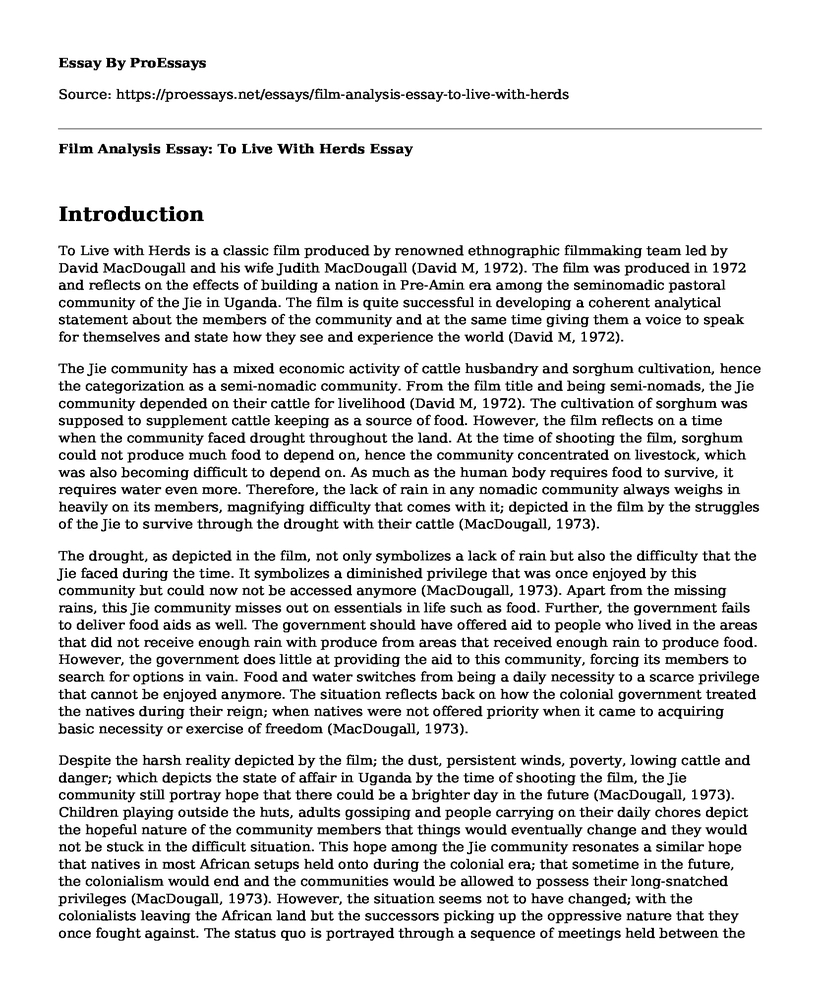Introduction
To Live with Herds is a classic film produced by renowned ethnographic filmmaking team led by David MacDougall and his wife Judith MacDougall (David M, 1972). The film was produced in 1972 and reflects on the effects of building a nation in Pre-Amin era among the seminomadic pastoral community of the Jie in Uganda. The film is quite successful in developing a coherent analytical statement about the members of the community and at the same time giving them a voice to speak for themselves and state how they see and experience the world (David M, 1972).
The Jie community has a mixed economic activity of cattle husbandry and sorghum cultivation, hence the categorization as a semi-nomadic community. From the film title and being semi-nomads, the Jie community depended on their cattle for livelihood (David M, 1972). The cultivation of sorghum was supposed to supplement cattle keeping as a source of food. However, the film reflects on a time when the community faced drought throughout the land. At the time of shooting the film, sorghum could not produce much food to depend on, hence the community concentrated on livestock, which was also becoming difficult to depend on. As much as the human body requires food to survive, it requires water even more. Therefore, the lack of rain in any nomadic community always weighs in heavily on its members, magnifying difficulty that comes with it; depicted in the film by the struggles of the Jie to survive through the drought with their cattle (MacDougall, 1973).
The drought, as depicted in the film, not only symbolizes a lack of rain but also the difficulty that the Jie faced during the time. It symbolizes a diminished privilege that was once enjoyed by this community but could now not be accessed anymore (MacDougall, 1973). Apart from the missing rains, this Jie community misses out on essentials in life such as food. Further, the government fails to deliver food aids as well. The government should have offered aid to people who lived in the areas that did not receive enough rain with produce from areas that received enough rain to produce food. However, the government does little at providing the aid to this community, forcing its members to search for options in vain. Food and water switches from being a daily necessity to a scarce privilege that cannot be enjoyed anymore. The situation reflects back on how the colonial government treated the natives during their reign; when natives were not offered priority when it came to acquiring basic necessity or exercise of freedom (MacDougall, 1973).
Despite the harsh reality depicted by the film; the dust, persistent winds, poverty, lowing cattle and danger; which depicts the state of affair in Uganda by the time of shooting the film, the Jie community still portray hope that there could be a brighter day in the future (MacDougall, 1973). Children playing outside the huts, adults gossiping and people carrying on their daily chores depict the hopeful nature of the community members that things would eventually change and they would not be stuck in the difficult situation. This hope among the Jie community resonates a similar hope that natives in most African setups held onto during the colonial era; that sometime in the future, the colonialism would end and the communities would be allowed to possess their long-snatched privileges (MacDougall, 1973). However, the situation seems not to have changed; with the colonialists leaving the African land but the successors picking up the oppressive nature that they once fought against. The status quo is portrayed through a sequence of meetings held between the African, non-Jie, District commissioner and Jie group of village elders; where little understanding can be reached between the two parties. Similarly little understanding often resulted between natives and colonialists during the colonial era (David M, 1972). However, towards the end of the film, the impact of the outside world is seen; cattle sales and famine relief finally get to Jieland as support, depicting a bright day after the struggles through the tough times.
Conclusion
In conclusion, the film broadly depicts neo-colonization that still thrives in African communities, centuries after the white colonialists left the continent. Africans expected the return of their privileges that were once snatched from them only to see their leaders turn on them and continue oppressing them to the extent of not supplying basic necessity for their survival (MacDougall, 1973).
References
David M, J. M. (Director). (1972). To Live with Herds [Motion Picture].
MacDougall, D. (1973). To Live with Herds. Royal Anthropological Institute.
Cite this page
Film Analysis Essay: To Live With Herds. (2022, Aug 05). Retrieved from https://proessays.net/essays/film-analysis-essay-to-live-with-herds
If you are the original author of this essay and no longer wish to have it published on the ProEssays website, please click below to request its removal:
- The Comparison of the Paintings by J.M.W Turner and Paul Cezanne
- Essay Sample on Effects of Social Media to the Society
- An Evaluation of the Benefits of Journaling - Essay Sample
- Research Paper on Georgian Theatre History
- Comparison Between Singers and Performers Essay Example
- "Disobedience" Film Analysis Essay
- Black Women in the Male-Dominated Hip Hop Society: A Study Example







